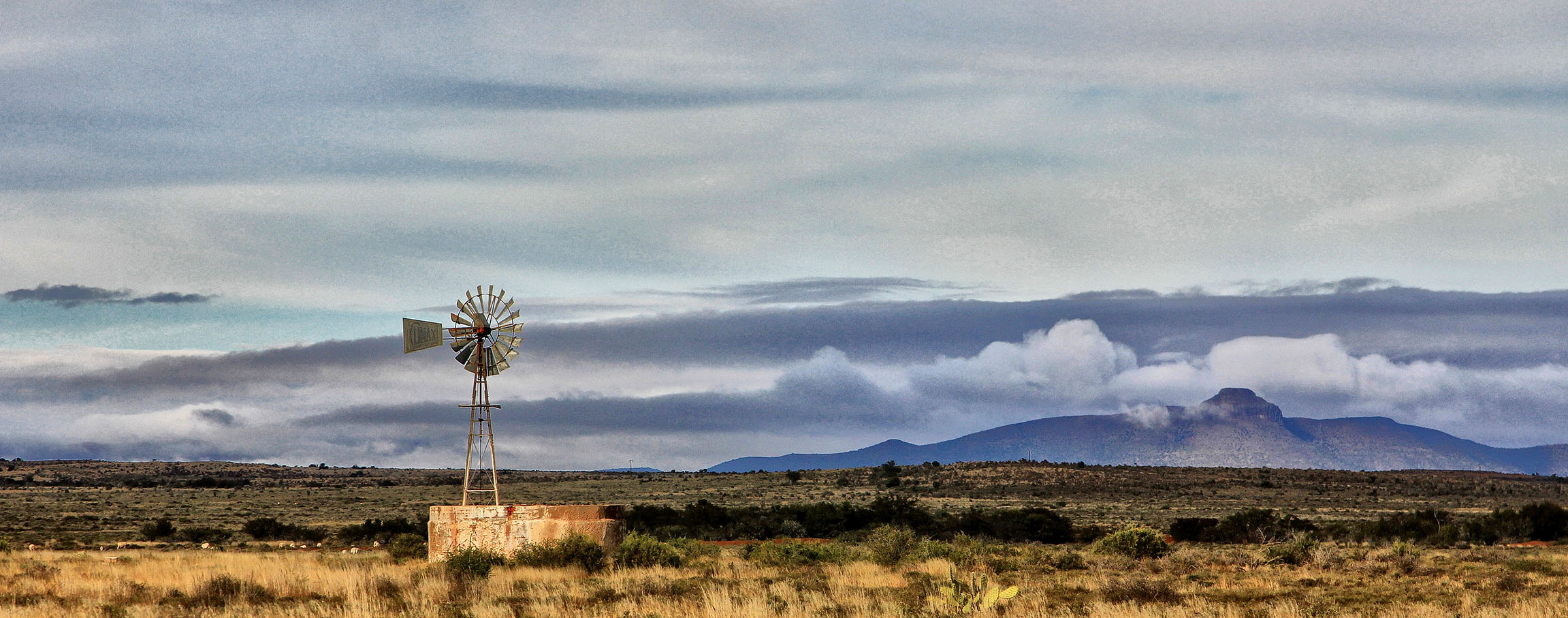The highlight event of Frank Wilke’s amazing zoo in the Eastern Cape Karoo village of Aberdeen took place in 1954 when local girl Numero Kilian married Wilhelm Pagel’s right-hand circus man Bubi Maier in the centre of a full lion cage.
Seven lionesses were in attendance – certainly the most bizarre bridesmaids ever seen in the Karoo.
The delightful Gina de Beer, a long-time local, has written a memoir called Ek Onthou Aberdeen (I Remember Aberdeen). In it, she tells of the popular Tickey Dam right next to Wilke’s zoo. It was where all the townsfolk swam and were occasionally baptised.
“One day, we children were out at the Tickey Dam when a man came running up and shouting that the lions had escaped,” she says.
“Most of the children bolted into the changing room and they locked the door. A rather stout lady and I were stuck outside. A policeman came to our rescue. He bent over so we could jump on his back and up to the roof.”
It’s a mental image that remains: with a big male lion approaching fast, a brave policeman offers his back as a springboard and a short, fat lady in a pencil skirt vaults up and onto the roof with the speed of an Olympic athlete.
Gina was even present at the famous “lion wedding”.
“One of the lions roared at the presiding magistrate so he decided to conduct the service from outside the cage,” she says.
The Monk in the Manor
A rather ribald monk leers down at evening diners from his wall-perch in Cradock’s Victoria Manor Hotel.
Known in these parts as The Monk with No Name or The Monk Who Really Should Be Holding Candles, it was discovered in a Port Alfred shop by Lisa and Cherie Antrobus, enterprising owners of The Vic.
The nameless but lusty monk epitomises part of the legend of this storied hotel, which was built back in the late 1840s.
/file/attachments/2984/The-Monk-in-the-Victoria-Manor-dining-room_Chris-Marais_1_246383.jpg)
As the decades passed, the Victoria Hotel became a bit of a grande dame in these parts. From its broekielace balcony (now gone), guests viewed the constant flow of commerce at the Cradock Marketplace down below.
They heard the roar of export-quality lions over at Töger van Abo’s animal pens and, at the turn of the century, they also witnessed the occupying British hanging a Cape rebel or two.
People used to drink in this place. Like the man who ripped up his precious yellowwood flooring to pay his bar bill, one plank at a time. Or the other man who rode his horse into the bar, where a special Cadillac hubcap full of beer awaited the eager steed.
Every day, the Vic is prepped as if Royalty were visiting within the hour. But no horses, hubcaps or Happy Hour barterers are allowed.
Return to sender
At Deelfontein Siding near Richmond in the Northern Cape, you might notice a more recent pile of rubble between the cemetery and the hotel.
This was once the Deelfontein Post Office That Never Was, and Yeomen of the Karoo by Rose Willis, Kay de Villiers and Arnold van Dyk has the story:
“Locals say that one day a train arrived, off-loaded building supplies and puffed off. Intrigued, they wondered just who had ordered so much building material and why. Before they could even ponder the answer, a second train arrived and off-loaded some work crews.”
/file/attachments/2984/Ruins-of-the-Accidental-Post-Office-at-Deelfontein-Siding_Chris-Marais_1_444357.jpg)
They built a post office (much like the hospital and the hotel, one surmises) in the middle of nowhere. It turned out that the building had been meant for Dealesville, not Deelfontein. It never opened, and was subsequently stripped and vandalised.
This happens quite a lot in South Africa’s heartland. There’s a similar story to do with the NG Mother Church in Adelaide, Eastern Cape.
Just after the South African War, a huge pile of high-quality wood arrived from England. Enterprising locals immediately crafted a fine set of church pews and a pulpit from this windfall.
A while later, the good folks of Adelaide, Australia, started making enquiries about their missing shipment of wood. Oops.
A tap on the road
The Karoo has strange roadside attractions, many of which are noticed only by the observant.
But one, on the road between Uniondale and Willowmore, has a brown road sign to point it out. The sign indicates a water tap, which stands to the side of a small shelter with picnic tables. It’s low down, wedged into a metal and concrete circle that contains the following words neatly scratched into the cement: “Water is Kosbaar” (water is precious). The tap works perfectly, and from it gushes pure Karoo spring water.
/file/attachments/2984/The-famous-roadside-tap-between-Uniondale-and-Willowmore-offering-travellers-delicious-spring-water-for-free_Chris-Marais_1_880367.jpg)
Farmer Meyer van Rensburg of the adjoining farm Groenrand put it there many years ago. According to his son Danie, Meyer had always been grateful for the glorious sweet water that flowed constantly from a mountain spring on his farm. He felt he should share it with thirsty wayfarers.
Many travellers stop beside the road to use it – filling up bottles, radiators or doggie water bowls. Water is highly treasured in this part of the Karoo. In 2012, Meyer van Rensburg died. His son Danie took over Groenrand. The tap, vowed Danie, will remain unchanged.
So, if you’re in the area, stop and drink the sweet water of the Kouga Mountains. Raise a glass to the legacy of Meyer van Rensburg – a grateful man in a dry land, who shared his good water with strangers. DM
For an insider’s view on life in the South African Heartland, get the Karoo Quartet set of books (Karoo Roads I-IV with black and white photographs) for only R960, including taxes and courier costs in South Africa. For more details, contact Julie at julie@karoospace.co.za




 High jinx on the Plains of Camdeboo, where the Karoo villages keep their delightful secrets. (Photo: Chris Marais)
High jinx on the Plains of Camdeboo, where the Karoo villages keep their delightful secrets. (Photo: Chris Marais)